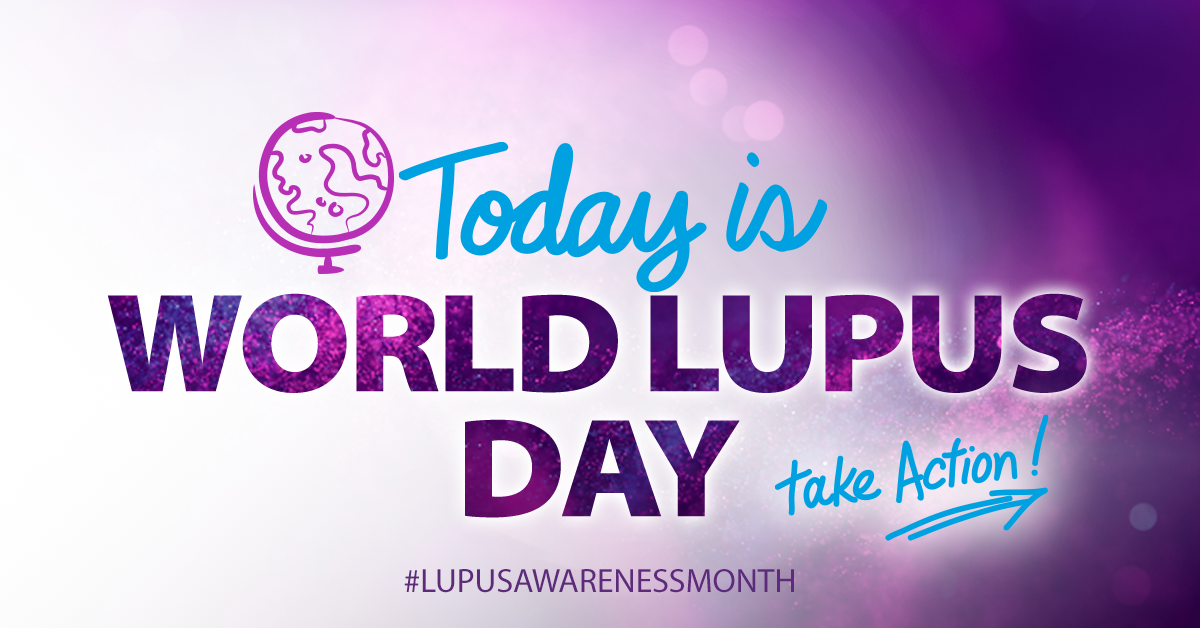

Guest Blog: May 10 is World Lupus Day!
By: The Lupus Foundation of America
May is Lupus Awareness Month, a time to bring attention to lupus — a chronic autoimmune disease that occurs when the immune system begins attacking the body it is supposed to protect and causes inflammation and pain in the body. Over time, this chronic inflammation can cause permanent organ damage. The Lupus Foundation of America (LFA) estimates that 1.5 million people in the U.S. have some form of lupus.
As part of our Lupus Awareness Month campaign, LFA works to educate communities and increase awareness by informing people about this cruel disease. We created resources such as the Lupus Awareness Month Toolkit to help people explore ways to get involved, access resources, and share information on social media to create greater awareness and understanding of lupus.
Understanding Lupus
The most common form of lupus is systemic lupus erythematosus (SLE). Most people with lupus have SLE, which can affect any part of the body. There are other types of lupus that are limited to the skin or are caused by certain medications. There is also a complication of lupus that affects the kidneys called lupus nephritis.
The signs and symptoms of lupus are the same for women, men, and nonbinary people. Common symptoms are extreme fatigue, pain or swelling in the joints, headaches, and chest pain when breathing deeply. Almost everyone with lupus has some sort of skin involvement, which can take the form of rashes, sores, sensitivity to light, or hair loss.
Anyone can develop lupus, but it is most commonly diagnosed in women between the ages of 15-44. Women who are members of racial and ethnic minority groups are at higher risk of developing the disease. Although only about 10% of people with lupus are men, they tend to have a more severe form of the disease. Because lupus affects people in different ways, not everyone will experience the same symptoms.
Diagnosing lupus can be difficult. There’s no one test that can give a clear “yes” or “no,” which means it can take years or months to get an answer. To determine if someone has lupus, doctors will usually begin with a detailed health history and family history, including asking about the duration and severity of symptoms. They may also ask for blood tests, urine tests, and biopsies. No one knows exactly what causes lupus, but a person’s genetics and environment likely play a role in developing the disease.
Several disparities exist in lupus prevalence and outcomes between Black/African American, Asian American/Pacific Islander (AAPI), Hispanic/Latino, and Native American/Alaska Native (NA/AN) compared with white populations. Lupus is three times more prevalent in Black/African American and Native American/Alaska Native populations than in white populations. Lupus is twice as prevalent in Hispanic/Latino populations compared to white populations. In addition, the prognosis is worse for racial and ethnic minorities with lupus. It’s estimated that Black/African American women with lupus die up to 13 years earlier than non-Hispanic white women with lupus. Moreover, rates of lupus nephritis and cardiovascular disease are higher across all marginalized racial and ethnic minority groups compared to white populations and are among the leading causes of death for people of color with lupus.
While there is no cure for lupus, there are treatments available. Most people with lupus are able to control their disease with medications and lifestyle changes and achieve a high quality of life. Learning about the disease and developing disease self-management skills can help.
Lupus Education and Awareness
The LFA has many resources for people with lupus and their family and caregivers. All of our education and disease self-management resources are free to the user:
- We have Health Education Specialists available by phone or email, who can help answer questions about lupus.
- We also offer webinars called Lupus & You, an educational series where people with lupus can learn more about the latest lupus research and disease management.
- We produce a podcast called The Expert Series where we interview lupus experts on topics related to lupus.
- We created a mobile app called SELF, which can help people with lupus gain skills to manage symptoms, stress, medication and improve communication with their health care team.
- We curated the National Resource Center on Lupus, a living collection of resources in both English and Spanish with up-to-date information on lupus – allowing people with lupus to learn how the disease can affect them and strategies to help them cope.
Throughout May, the LFA will shine a spotlight on different lupus topics and provide important resources to help raise awareness across our social media platforms. The theme for Lupus Awareness Month this year is “Make Lupus Visible.”
During each week, the LFA will highlight four people with lupus who will share different aspects of their lives with lupus. Everyone is invited to join the lupus community to Make Lupus Visible by visiting the LFA’s official digital toolkit. This toolkit provides all information and resources you need, including sample social media posts, shareable images, lupus facts and infographics, on our Lupus Awareness Month website.
World Lupus Day
Today, on May 10, the LFA along with other lupus advocacy organizations around the world celebrate World Lupus Day. The World Lupus Federation, which is led by the LFA, established World Lupus Day to unite lupus groups around the world during Lupus Awareness Month and call attention to the disease’s impact on the millions of people globally affected by lupus. As we celebrate World Lupus Day today, it is crucial that we continue to advocate for improved access to safe and effective treatments for lupus. On this special day, everyone is encouraged to Put on Purple for World Lupus Day, share why they are wearing purple, and why we need greater awareness of lupus.
The World Lupus Federation is encouraging people around the globe today for World Lupus Day to share facts about lupus, including from this survey, and raise awareness using the official World Lupus Day Toolkit.
A special highlight of Lupus Awareness Month this year is the National Lupus Advocacy Summit, the largest in-person lupus advocacy event, held in Washington, DC May 19-21. This is one of the LFA’s signature events. The Summit truly underscores the importance of garnering support for the lupus cause, aiming to secure increased funding for lupus research, improve access to care for those affected by this challenging disease, and facilitate meetings between lupus advocates and their representatives to advance policies to improve the lives of all people with lupus. Though the in-person registration for the Summit is sold out, anyone can participate in the programming portion of the Summit through a livestream of several sessions. Register here to access the Summit livestream on May 20.
The Lupus Foundation of America is a member of the National Health Council. For more information on NHC membership, please email membership@nhcouncil.org.


